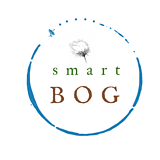The SmartBog project is drawing on the expertise of scientists across Ireland to assess how our management of peatlands has influenced their function. Here Dr Matthew Saunders,
School of Natural Sciences, Trinity College Dublin, writes about his work on the project.
The SmartBog project is funded by the Environmental Protection Agency and centres on raised bogs located in the midlands of Ireland, many of which have been altered through the extraction of peat for energy or horticulture, but are now the focus of rehabilitation to address the key issues of climate mitigation and biodiversity loss.
Peatlands are incredibly important in relation to climate, as explained by the International Union for the Conservation of Nature (IUCN) - they store vast amounts of carbon, more than all of the other vegetation on Earth combined on a very small area (about 3% of the total land mass). In Ireland though, nearly 20% of our land area is covered by peatlands and they hold up to 75% of all carbon stored in our soils, this is why the conservation of these systems forms an integral part of the national climate action plan.
The project team come from a range of disciplines (Botany, Geography, Engineering and Computer Science to name a few) and are working at a range of sites including near-natural bogs, sites that have been drained and peat extracted, where enhanced rehabilitation is being applied and areas that have been rewetted (see Figure 1).

Figure 1. Example of a near-natural raised bog (a), a site that has been drained and peat extracted (b), an example of the early stages of enhanced rehabilitation on a former extraction site (work being undertaken by Bord na Mona) (c) and a former extraction site that has been rewetted (d).
Information from satellites and drones is being used to map the area, extent, use and ecological condition of these systems, with particular focus on the presence, activity, and impact of drains on and around peatland areas (Figure 2).

Figure 2. Example of drain detection on peatlands using object based image analysis using Geoeye-1 imagery. Further details can be found in Connolly and Holden (2017).
These sites are also being used to assess the carbon and greenhouse gas dynamics of these systems to better understand if they are net sinks of carbon and are a useful mitigation tool, or they have a net warming effect on the climate. We are using state-of-the-art techniques and have installed eddy covariance flux towers at a number of sites which measure the peatland to atmosphere exchange of carbon, and are using portable analysers to better understand the emission of other important greenhouse gases such as methane in the climate feedback cycle (Figure 3).

Figure 3. An example of an eddy covariance tower to measure ecosystem to atmosphere exchange of carbon (a), and a portable system to measure soil derived emissions of other key greenhouse gases such as methane.
Losses of carbon to our waterways is also being assessed using flumes (see Figure 4), that will allow us to fully quantify the carbon budgets of these systems, while new and novel IoT sensors are also being tested to see how such lower cost approaches can increase data coverage of the key variables that will help us better understand the drivers of carbon uptake and release from these systems.

Figure 4. Examples of the flumes used to monitor aquatic losses of carbon from peatlands.
Finally, all of the information collected through this work is being compiled in an interactive dashboard, making the information accessible to key stakeholders who can use it to further inform the wider debate around suitable management plans for the rehabilitation of peatland systems.
See http://smartbog.com/ for more information.


